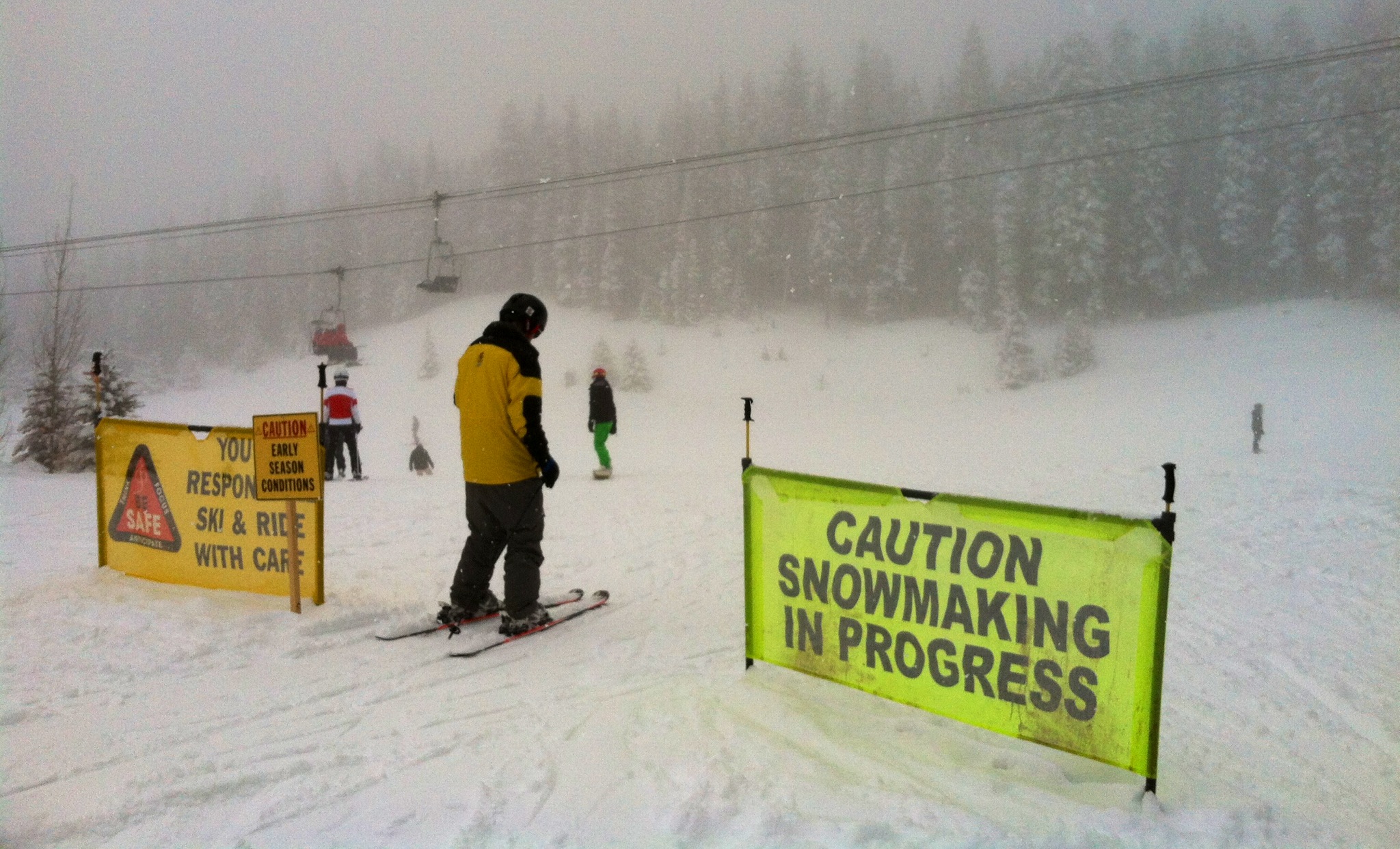By Fiona Smith

Skiers around the state (and world) enjoy the benefits of snowmaking.
During the 2013-2014 ski season, Colorado saw 12.6 million skier visits. The ski industry across the United States alone generated around $12.2 billion during the 2009-2010 season. What makes it tick? What lies beneath that fresh corduroy and is responsible for Arapahoe Basin’s October open dates? Snowmaking. According to Winter Park Resort’s Slope Supervisor, Ron Richard, “Every other year we wouldn’t be able to open the way we do without snowmaking.”
In 1976, Winter Park became one of Colorado’s first resorts to use snowmaking. The tool is credited with saving the resort during one of the driest winters ever seen in the region. Winter Park’s snowmaking infrastructure now covers 300 acres across the resort.
While many ski areas in Colorado use automated equipment for their snowmaking, Winter Park continues to operate a manual system. “We have some guns you could operate with an app on your phone,” says Bob Dart, Winter Park’s Mountain Maintenance Director, “but most of our guys like to check them manually anyway.”
Bob Dart and his team run their snowmaking operations from the second week in October until the end of December. 28 degrees Fahrenheit is the magic number that allows their guns to make water into snow. Dart’s eight employees, many of whom boast 20 years of seniority, work 24-7 shifts during peak snowmaking times to earn their season pass.

Bob Dart, Winter Park’s Mountain Maintenance Director, displays a map of the resort’s snowmaking system. Each dot on the map represents one of the hydrants which connects 80,000 feet of buried pipe.
Winter Park primarily uses air-water guns, which pressurize the water they spew with air that is adjusted from a control center low on the mountain. These guns pump water at 100 gallons per minute. One person manages the control room, turning on the water and adjusting the air pressure. The other seven work in groups of two out in the field, checking on and adjusting the guns. Through calculated gun placements, the team makes numerous piles of snow along the high-traffic trails. When they are big enough, a snow cat comes through and moves the snow wherever it needs to go.
“Our goal is to make snow as quickly as possible and have enough coverage to last all season in the high traffic areas.” –Bob Dart, Winter Park Mountain Maintenance Director

This control panel in the control center powers and adjusts the air pressure for all of Winter Park’s hydrants.
Every two hours, Dart’s team checks on the guns stationed around the resort- altering their position or changing the pressure of the gun. 80,000 feet of buried water and pipes wind under the snow around Winter Park and Mary Jane. Connecting those pipes are the hydrants, which are in turn connected to the hoses that run to the guns (some of which stretch 300 feet). As often as they are checked, it is inevitable that a hose will freeze. Dart explained, “The snow you want will bounce off your jacket. If you see its sitting on your coat, you know that something needs to be checked.” The only way to fix a hose is to haul all 300 feet of the culprit into the Control Center and let it thaw.
Winter Park’s total water consumption last year was 72 million gallons or around 220 acre feet of water. Most of this is pumped from the Vasquez Canal and returned to the canal when it melts at the end of the season. Through a series of agreements, including the Colorado River Cooperative Agreement, Winter Park has an annual allotment of 550 acre-feet of water from Denver Water to use for snowmaking as long as all return flows can be returned to or recaptured by Denver Water’s collection system. This water is primarily reservoir yield from the Clinton Reservoir. Dart explains, “As long as I have three inches of water in the canals, we can pump at least 1000 gallons per minute.” 20 percent of the water is lost to evaporation but for the most part, the system is closed-what they take they return. The only situation in which Winter Park cannot use its full allotment of water for snowmaking, is in the event that Green Mountain and Dillon Reservoirs do not fill. Read more about the Colorado River Cooperative Agreement, this transbasin diversion system and others in CFWE’s Citizen’s Guide to Colorado’s Transbasin Diversions.
While the equipment might be old-school, Winter Park’s snowmakers are looking toward improvements. They are currently in the process of replacing their piping, a project they must attend to at least every five years. Additionally, as a benefit of the Colorado River Cooperative Agreement, the Resort has the opportunity to build a Fraser River pipeline that will allow recapture of more snowmaking water and a forty acre-foot holding pond on the resort. This will revolutionize the snowmaking schedule since they will no longer be solely dependent upon diurnal fluctuations.
The primary concern for the resort right now and an issue Bill Baum, General Counsel for Intrawest Colorado which manages Winter Park, has spent countless hours addressing, is that of the Federal Ski Area Water Rights Directive. This 2011 directive required ski areas applying for a permit to use Forest Service land, to assign or convey water rights to the Forest Service. The directive conflicts with Colorado’s Prior Appropriation system as it requires that private water rights be handed over to the federal government without just compensation. Since these water rights are crucial to maintaining the recreational and economic benefits of skiing in Colorado, this is an important and ongoing issue.

Attendees of the Colorado Water Congress POND Ski Day pose at the base of Winter Park Resort.
Supported by the Colorado Water Congress, Colorado State Senator Jerry Sonnenberg is sponsoring a 2015 bill (SB15-064), which would develop certain protections for ski area water rights against these federal taking claims. The bill was drafted and is primarily represented by the Boulder-based water law firm Porzak, Browning and Bushong LLP. To learn more about SB15-064 please click here.
This post was written as a summary of the tour and presentations during the Colorado Water Congress Professional Outreach Networking and Development (POND) Committee’s 2015 Ski Day at Winter Park. For more information on the Colorado Water Congress and its upcoming events, please visit: www.cowatercongress.org.
 Fiona Smith is the Member Outreach and Relations Manager for the Colorado Water Congress, a membership organization established in 1958 to provide leadership on key water resource issues and serve as the principal voice of Colorado’s water community. Prior to moving to Denver in 2013, she taught environmental education in her native state of Washington and spent three years in Telluride. There, she lived a double-life, managing an energy conservation program and ski patrolling. She received her BA in Geology from The Colorado College.
Fiona Smith is the Member Outreach and Relations Manager for the Colorado Water Congress, a membership organization established in 1958 to provide leadership on key water resource issues and serve as the principal voice of Colorado’s water community. Prior to moving to Denver in 2013, she taught environmental education in her native state of Washington and spent three years in Telluride. There, she lived a double-life, managing an energy conservation program and ski patrolling. She received her BA in Geology from The Colorado College.
 Want to learn more about snowmaking? Listen to this story focusing on snowmaking at Aspen and Snowmass produced in partnership with Rocky Mountain Community Radio stations and CFWE as part of our Connecting the Drops series. Then read “Bring on the Snow” and “Nature’s Reservoir at Risk” in the Winter 2013 issue of Headwaters magazine.
Want to learn more about snowmaking? Listen to this story focusing on snowmaking at Aspen and Snowmass produced in partnership with Rocky Mountain Community Radio stations and CFWE as part of our Connecting the Drops series. Then read “Bring on the Snow” and “Nature’s Reservoir at Risk” in the Winter 2013 issue of Headwaters magazine.

 Print
Print
Reblogged this on Coyote Gulch.
POND provides great opportunities for CWC members to learn about Colorado water and to network. Fun? That’s the best part.